Layer 1 blockchains are core networks supporting numerous purposes straight on their protocol, whereas Layer 2 blockchains work on prime of those core layers, rising scalability and effectivity. Evaluating the utilization and effectivity of EVM suitable L1 and L2 blockchains and sidechains helps us higher perceive the market values and the place many of the DeFi exercise is coming from.
Dune Analytics knowledge analyzed by fromcrypto confirmed that Polygon, a Layer-2 sidechain, was the main determine within the DeFi ecosystem, intently adopted by BNB Chain, an EVM-compatible Layer-1 blockchain.
One of the crucial vital metrics when analyzing L1 and L2 is the day by day gasoline consumption – the computational effort required to carry out operations on the blockchain. Fuel charges are paid in native blockchain currencies and excessive gasoline consumption normally signifies sturdy community exercise. Notably, when L2 options preserve excessive gasoline consumption at low USD prices, this displays an environment friendly scaling answer that makes transactions out there with out sacrificing blockchain exercise.
Polygon makes use of a median of 579.97 billion models of pure gasoline per day, with related prices of solely $65.48 thousand. This interprets to a modest common of $0.76 USD per second regardless of processing a excessive quantity of 48.37 transactions per second. Every transaction on Polygon prices about 138,782 models of gasoline. The BNB Mainnet, whereas additionally excessive in transaction quantity, exhibits a distinct value construction with 454.89 billion models of native gasoline consumed day by day and $1.02 million in day by day USD charges; the worth per second climbs to $11.81, far surpassing Polygon. The upper value per transaction, which averages 108,513 gasoline models, displays BNB's larger computational effort per transaction, suggesting a extra resource-intensive operation than Polygon.
| Chain | Common consumption of native gasoline / day | Avg. USD gasoline costs / day | Avg. variety of Txs / day | Avg. native gasoline on Tx | Common consumption of native gasoline / second | Avg. gasoline costs in USD per second | Avg. variety of Txs per second |
|---|---|---|---|---|---|---|---|
| Polygon essential mesh | 579.97 b | 65.48 thousand {dollars} | 4.18 m | 138,782 | 6.71 m | $0.76 | 48.37 |
| BNB mainnet | 454.89 b | $1.02 million | 4.06 m | 108,513 | 5.26 m | $11.81 | 47.03 |
| Arbitrum one | 273.96 b | 250.05 thousand {dollars} | 1.14 m | 241,207 | 3.17 m | $2.89 | 13.15 |
| Core Mainnet | 222.37b | 378.72 thousand {dollars} | 1.26 m | 174,229 | 2.57 m | $4.38 | 14.59 |
| OP Mainnet | 213.30 b | 160.26 thousand {dollars} | 490.83 thousand | 429,129 | 2.47 m | $1.85 | 5.68 |
| Principal Gnosis Community | 109.77 b | 1.05 thousand {dollars} | 182.58 thousand | 601,244 | 1.27 m | 0.01 USD | 2.11 |
| Ethereum mainnet | 108.14b | 12.63 million {dollars} | 1.19 m | 90,758 | 1.25 m | $146.20 | 13.79 |
| Phantom Mainnet | 94.86 b | 4.89 thousand {dollars} | 248.93 thousand | 372,521 | 1.10 m | 0.06 USD | 2.88 |
Arbitrum consumes 273.96 billion models of gasoline per day, costing customers $250.05,050, which is $2.89 per second and 241,207 models of gasoline per transaction, exhibiting extra value effectivity than BNB, however lower than Polygon. The Base Mainnet sees comparable developments with 222.37 billion models and day by day charges of $378.72,000, leading to a barely larger worth per second of $4.38 and 174,229 models per transaction.
Ethereum operates with the very best value influence, utilizing 108.14 billion models of gasoline per day, representing $12.63 million in charges. With prices skyrocketing to $146.20 per second regardless of averaging 90,758 gasoline models per transaction, it illustrates Ethereum's sturdy safety and computational breadth and highlights its scalability challenges that L2 networks wrestle to deal with.
transaction metrics, April 23 knowledge exhibits that Polygon led the way in which with 4.02 million transactions, adopted by BNB Chain with 3.9 million. These numbers present sturdy consumer engagement and community utility, accounting for 25.8% and 25.1% share of whole transactions (excluding identified system transactions).
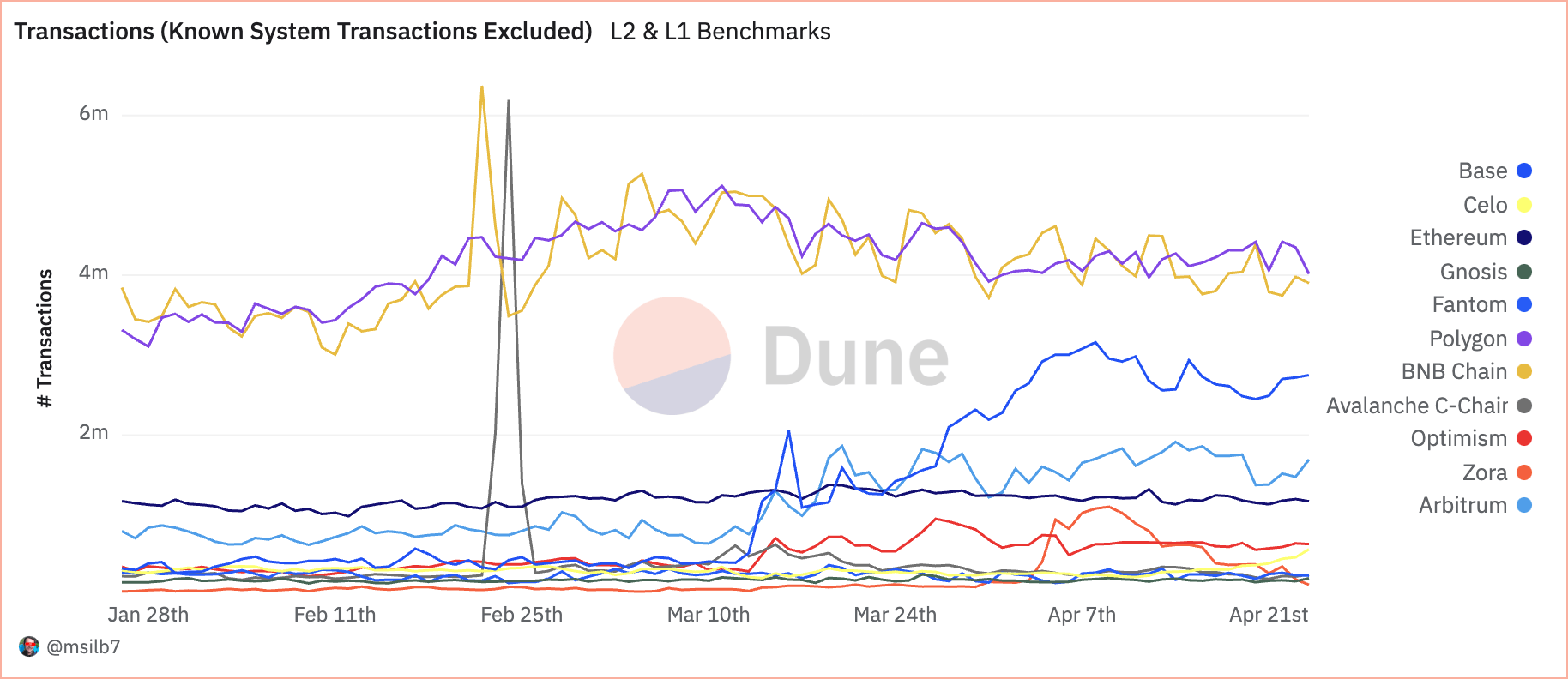
Nevertheless, a distinct story emerges when analyzing transaction charges. Regardless of the decrease variety of transactions, Ethereum gathered $7.46 million in charges, representing a staggering 83.9% of whole charges collected. This discrepancy means that whereas Ethereum processes fewer transactions, its larger transaction prices replicate its main layer standing and the intensive computing assets required for operations.
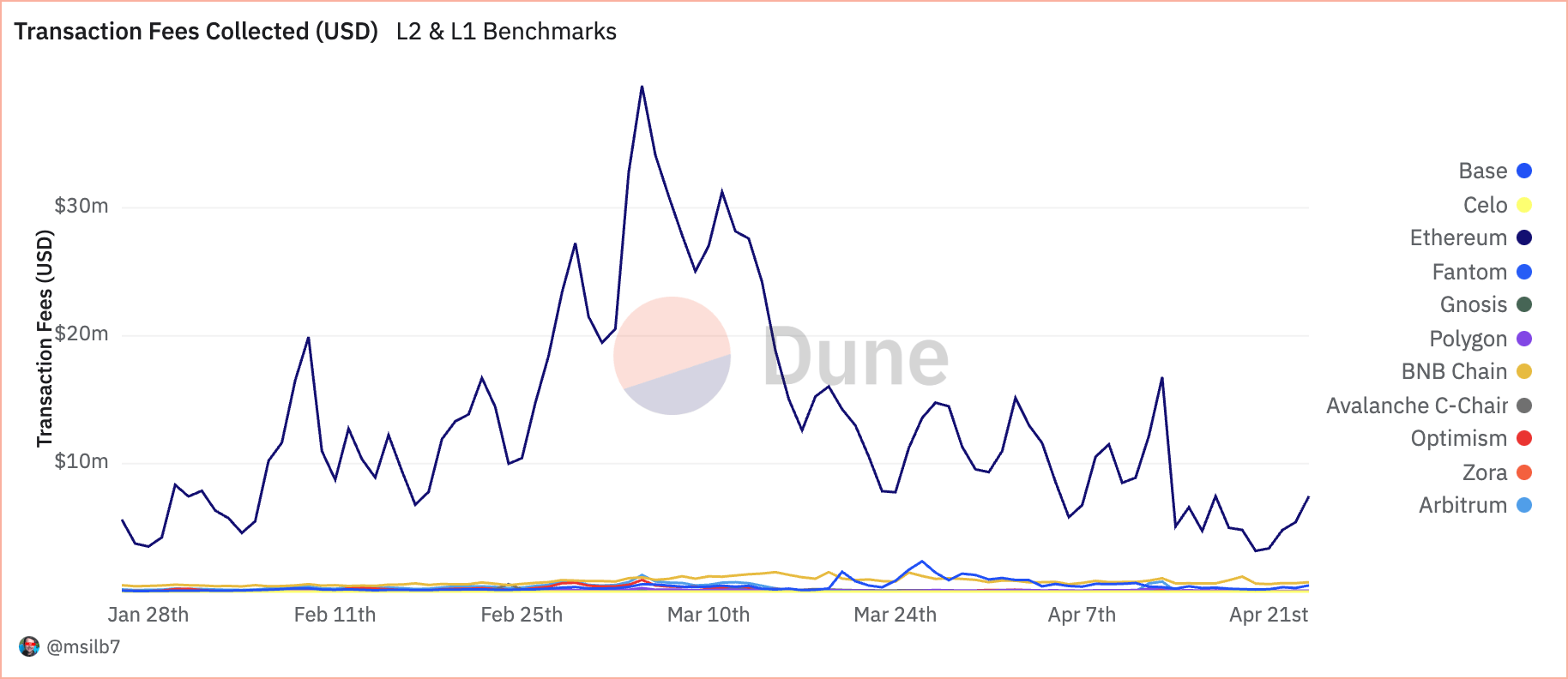

In relation to DeFi purposes, Polygon is as soon as once more main the variety of transactions with 3.3 million software transactions, exhibiting that it’s a platform for DeFi actions.
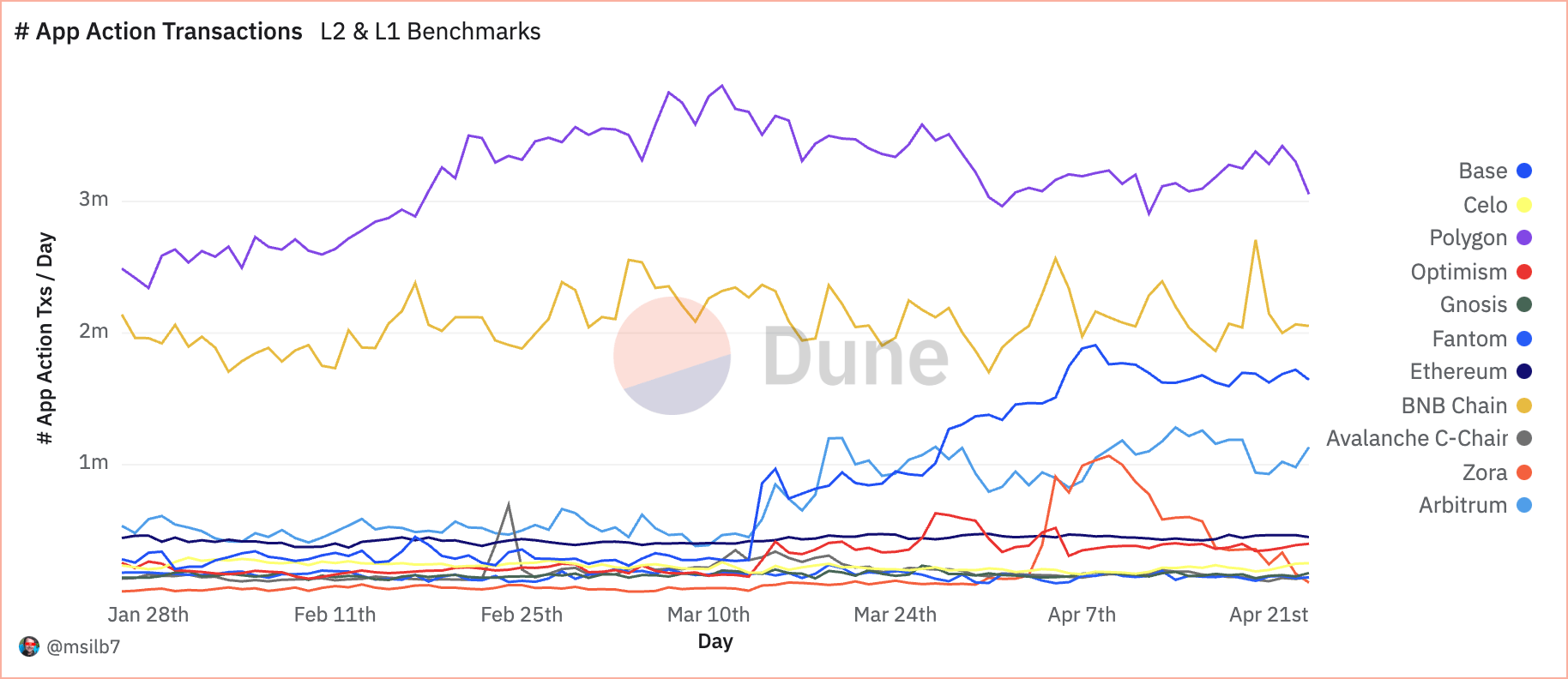

BNB Chain recorded 1.22 million transaction addresses, with Polygon barely behind at 1.18 million. These numbers, contrasted with Ethereum's 402.77k, counsel that different EVM-compatible networks have gotten the popular platforms for mainstream DeFi customers as a consequence of their decrease value constructions.
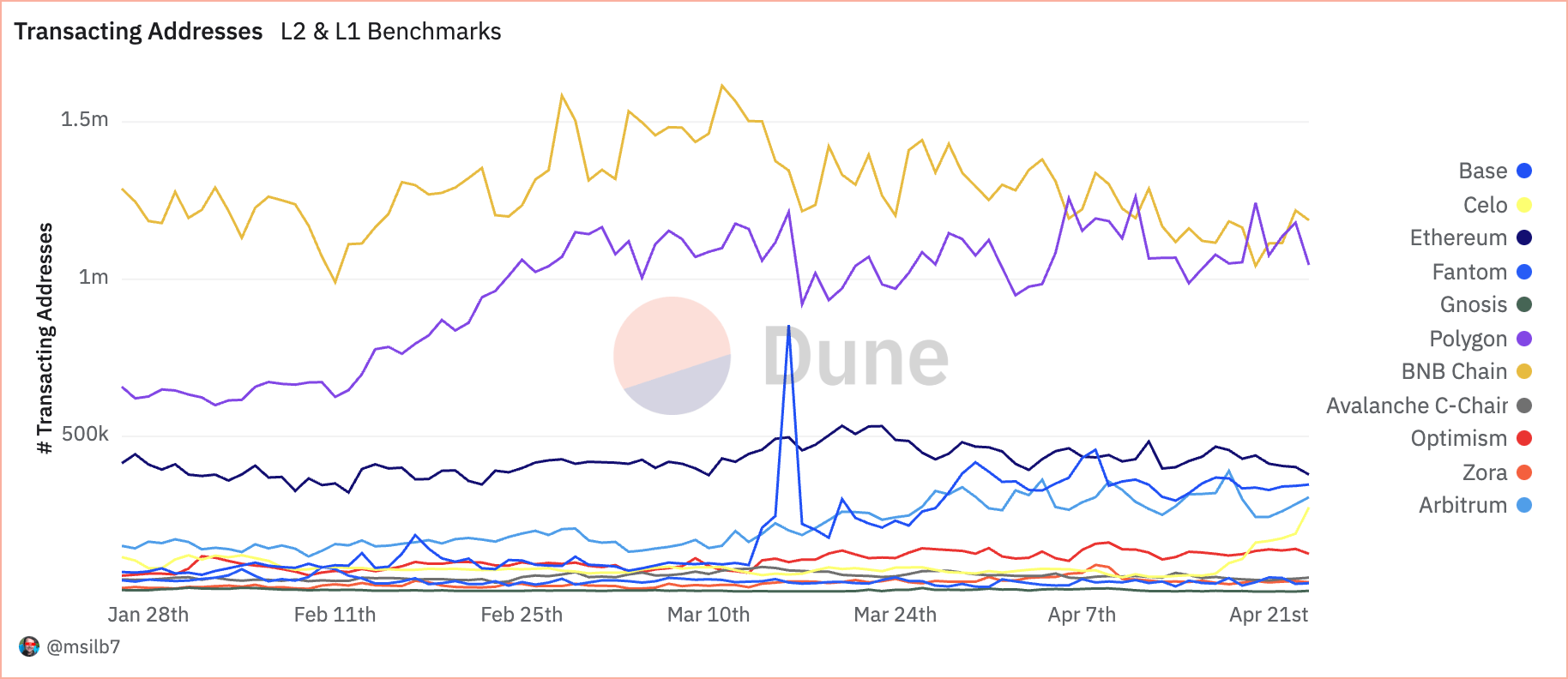

A side-by-side efficiency evaluation of those blockchains exhibits the battle between primary safety and enhanced scalability. Whereas L1 blockchains like Ethereum proceed to safe high-value transactions with vital charges, scaling options like Polygon seize many of the day-to-day transactions and software interactions, marking a shift to a extra environment friendly and user-friendly blockchain infrastructure in DeFi.
You will need to notice that though labeled by many as a Layer-2 blockchain, Polygon acts as an L2 sidechain for Ethereum because it depends by itself set of validators and doesn’t depend upon Ethereum for safety. This permits Polygon to help extra experimental actions than “actual” L2 blockchains with out affecting Ethereum. One other truth price noting is that BNB Chain is a Layer-1 blockchain suitable with EVM, however it was positioned out there not as a competitor to Ethereum, one other L1, however to different L2s.
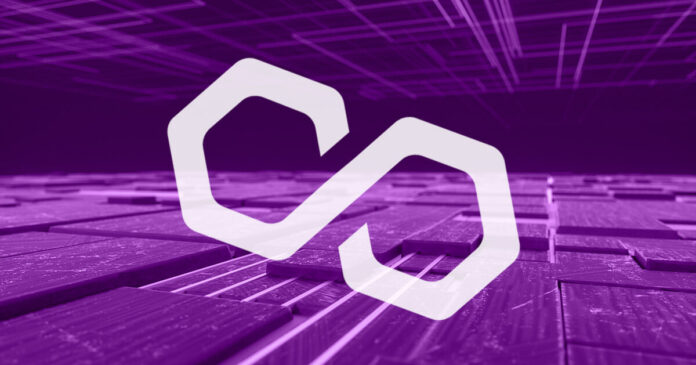
 Crypto belongings of the very best tier 2
Crypto belongings of the very best tier 2